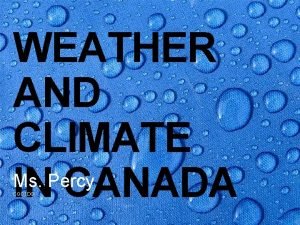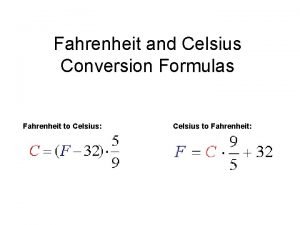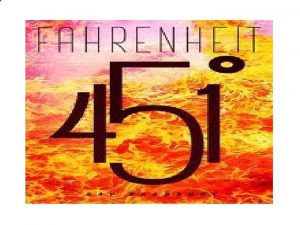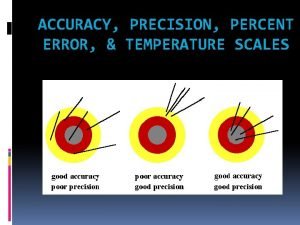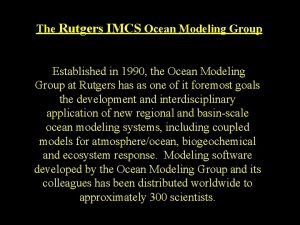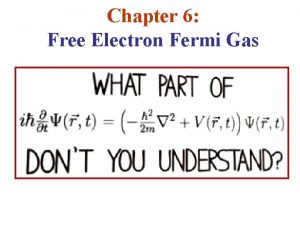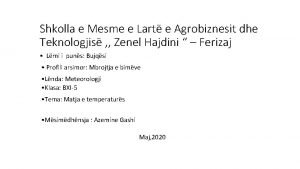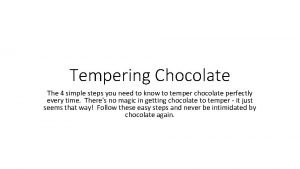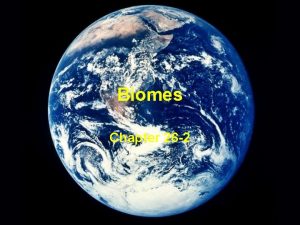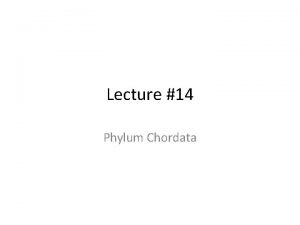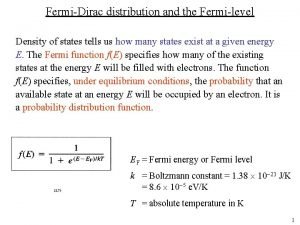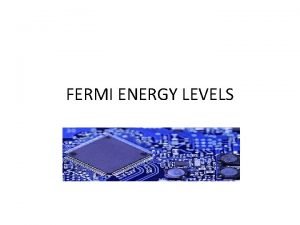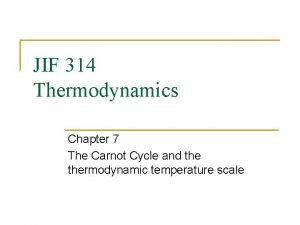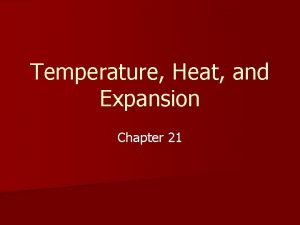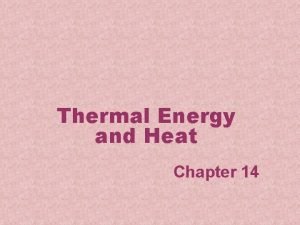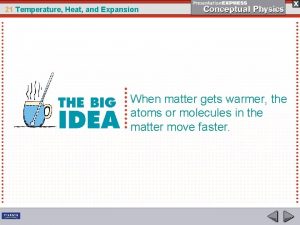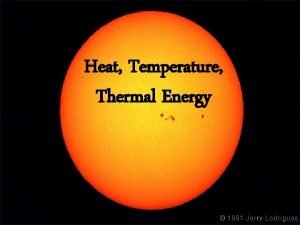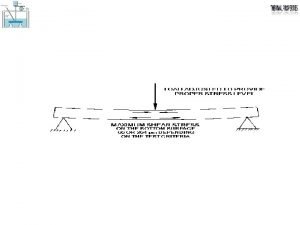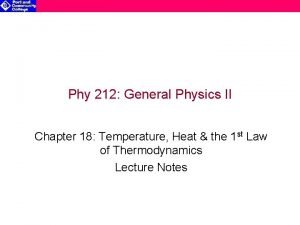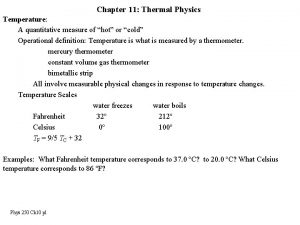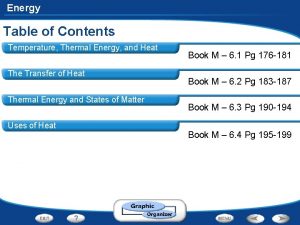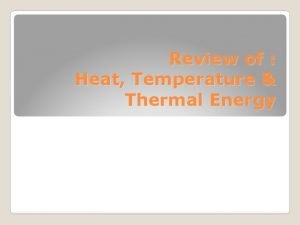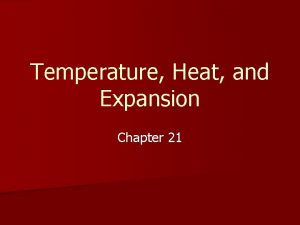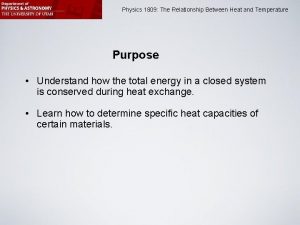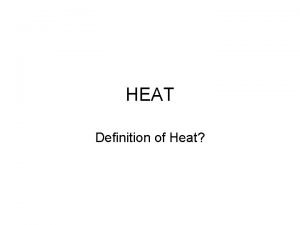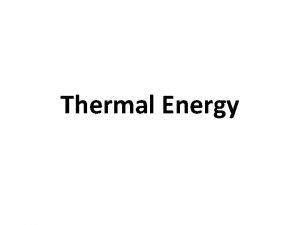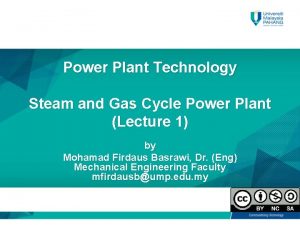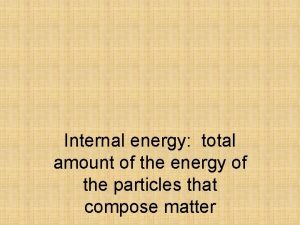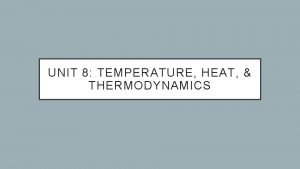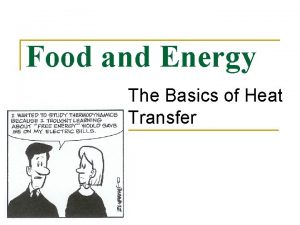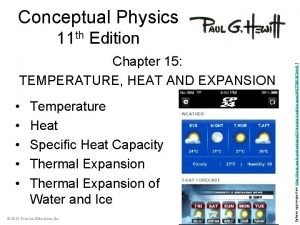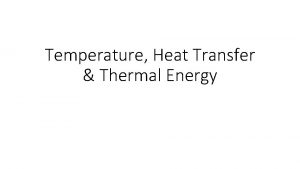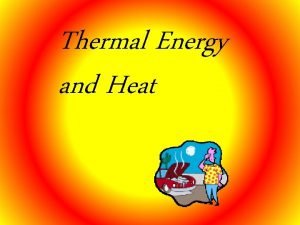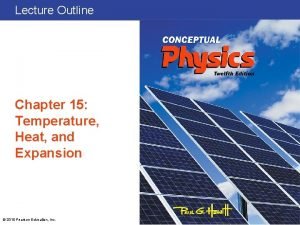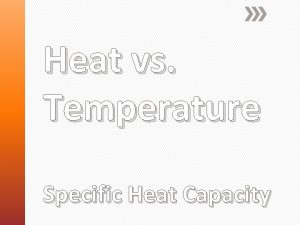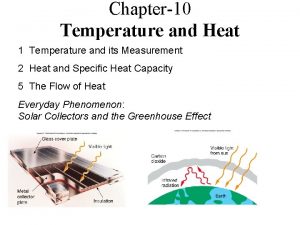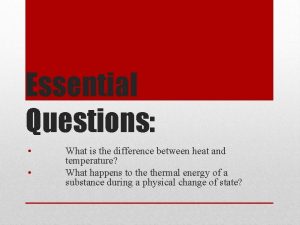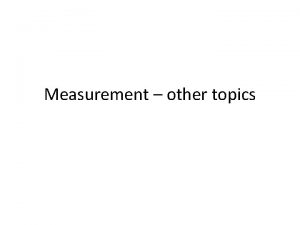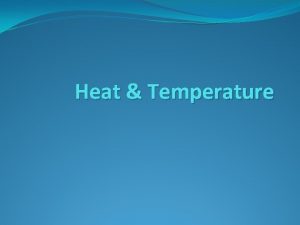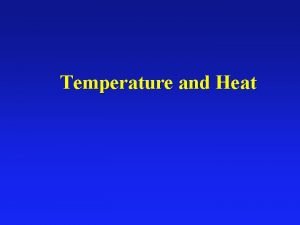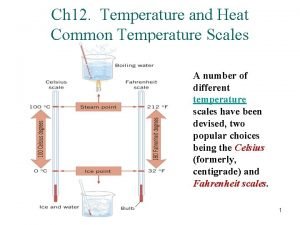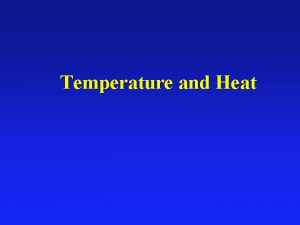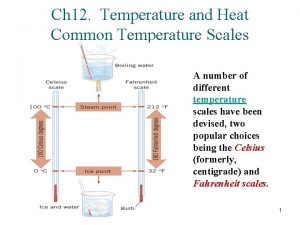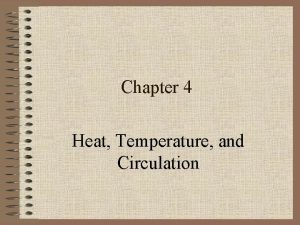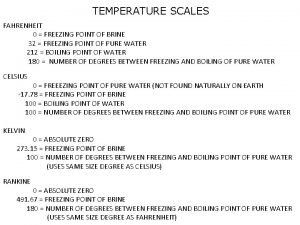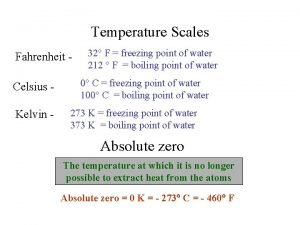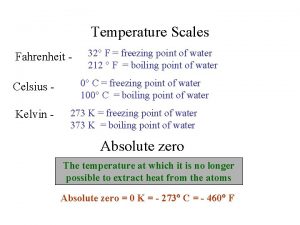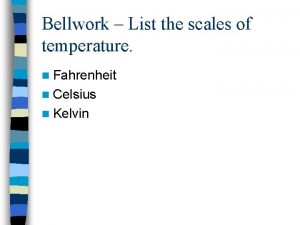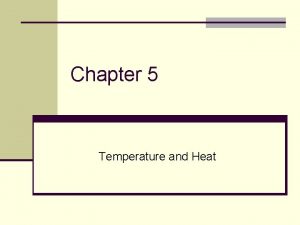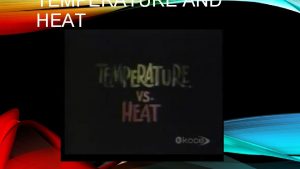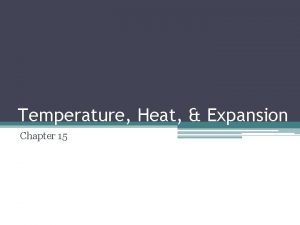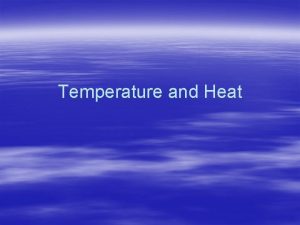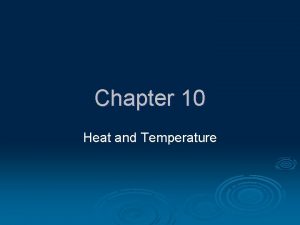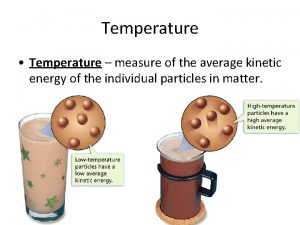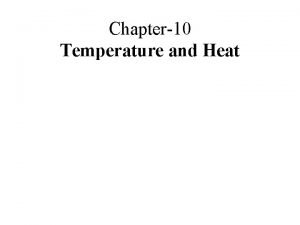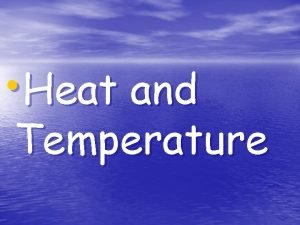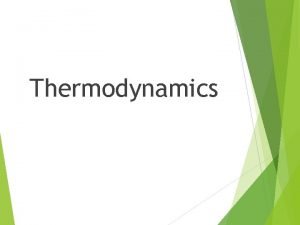HEAT Conversion Temperatures Temperature Scales n Fahrenheit n













































- Slides: 45

HEAT Conversion. Temperatures:

Temperature Scales n Fahrenheit n Celsius n Kelvin

Helpful Hints n Identify the equation needed. n Plug in the numbers to solve n Remember the math rules: • Solve what is in parenthesis first • Solve Multiplication & Division before addition and subtraction n Show all work n Put box around final answer

Solving 2–Step temperature equations n Necessary Ø K to o. F Ø o. F to K only when converting:

Temperature Conversion Equations n 4 equations to use: Ø o. F = 9/5 o. C + 32 Ø o. C = 5/9 (o. F-32) Ø K = o. C + 273 Ø o. C = K – 273

Convert 500 K to ____ F o n First convert K to o C – Use this equation: n Then o. C = K – 273 convert C to o F – Use this equation: o. F = 9/5 o. C + 32

Convert 500 K to ____ F o Step 1: n n n o. C = K – 273 o. C = 500 – 273 o. C = 227 Step 2: Ø Ø Ø o. F = 9/5 o. C + 32 o. F = 9/5(227) + 32 o. F = 1. 8(227)+ 32 o. F = 408. 6+ 32 o. F = 440. 60

Convert 70 o F to ____ K First convert o F to o C Use this equation: Then convert C to K Use this equation: o. C = 5/9 (o. F-32) K = o. C + 273

Convert 70 o F to ____ K Step 1: o. C = 5/9 (o. F-32) o. C = 5/9 (o 70 -32) o. C = 0. 55 (38) o. C = 2. 11 Step 2: K = o. C + 273 K = 2. 11 + 273 K = 275. 11

Units of Heat Objectives are to: n define and distinguish between various units of heat n define the mechanical equivalent of heat n discuss everyday examples to illustrate these concepts Temperature Conversions:

Units of Heat

Units of Heat n n n Heat is energy in transit, and is measured in energy units. The SI unit is the joule (J), or Newton-metre (Nm). Historically, heat was measured in terms of the ability to raise the temperature of water. The kilocalorie (kcal), or Calorie (Cal), or “big calorie”: amount of heat needed to raise the temperature of 1 kilogramme of water by 1 C 0 (from 14. 50 C to 15. 50 C) The calorie, or “little calorie”: amount of heat needed to raise the temperature of 1 gramme of water by 1 C 0 (from 14. 50 C to 15. 50 C) In industry, the British thermal unit (Btu) is still used: amount of heat needed to raise the temperature of 1 lb of water by 1 F 0 (from 630 F to 640 F)

Mechanical Equivalent of Heat Joule demonstrated that water can be heated by doing (mechanical) work, and showed that for every 4186 J of work done, the temperature of water rose by 1 C 0 per kg.

Mechanical Equivalent of Heat n Conversion between different units of heat: 1 cal = 10 -3 kcal = 3. 969 x 10 -3 Btu = 4. 186 J 1 Cal = 1 kcal=4186 J

Sensible Heat Objectives are to: n describe what is meant by 'sensible heat‘ n define specific heat n explain how the specific heat capacities of materials are obtained using calorimetry

Specific Heat Capacity Sensible heat is associated with a temperature change (can be “sensed”) n Different substances have different molecular configurations and bonding temperature change not generally the same for equal amounts of heat n Specific heat capacity, c: amount of energy needed to raise the temperature of 1 kg of a substance by 1 K n

Calorimeters

Calorimeters (contd. )

Calorimetry: An Exercise in Bookkeeping

Calorimetry: Finding Specific Heats

Calorimetry: Specific Heat

Calorimetry: Mixtures

Water: Specific Heat Capacities and Latent Heats

Water: Warming Curve

Water: Example Problem

Latent Heat Objectives are to: n Describe what is meant by ‘latent heat‘ n Compare and contrast the 3 phases of matter n Relatent heat to phase changes

Phases of Matter n Heat required for phase changes: – Vaporization: liquid vapour – Melting: liquid solid – Sublimation: solid vapour n Heat released by phase changes: – Condensation: vapour liquid – Fusion: liquid solid – Deposition: vapour solid

Phases of Matter

Latent Heat

Phase Diagrams

Phase Diagrams n Visual representation of phase changes n Triple point: point at which all three phases coexist n Curves branching out from this point separate phase regions: – Fusion curve: solid-liquid boundary – Vaporization curve: liquid-gas boundary – Sublimation curve: solid-gas boundary

Phase Diagram: Water

Phase Diagram: Carbon Dioxide

Methods of Heat Transfer Objectives are to: n describe three methods of heat transfer n Give practical/environmental examples of each

Thermal Conduction

Convection

Radiation n Heat transfer by electromagnetic waves n Does not need a material medium n Black body: perfect absorber perfect emitter (at all wavelengths)

Radiation

Convection

Convection at Home

Convection

Greenhouse Effect

Greenhouse Effect

Heat Transfer

Radiation
 Canada heat wave temperatures
Canada heat wave temperatures Fahrenheit to celsius equation
Fahrenheit to celsius equation 451 degrees
451 degrees Does percent error measure accuracy or precision
Does percent error measure accuracy or precision Ferrimagnetism
Ferrimagnetism Difference between curie temperature and neel temperature
Difference between curie temperature and neel temperature Difference between curie temperature and neel temperature
Difference between curie temperature and neel temperature Rutgers sea water temps mid atlantic
Rutgers sea water temps mid atlantic Fermi function
Fermi function Instrumenti per matjen e temperatures se ajrit
Instrumenti per matjen e temperatures se ajrit Tempering chocolate temperatures chart celsius
Tempering chocolate temperatures chart celsius Servsafe 3 compartment sink temperatures
Servsafe 3 compartment sink temperatures Cool treeless and dry
Cool treeless and dry Classification of phylum chordata
Classification of phylum chordata Fermilavel
Fermilavel Law of intermediate metals
Law of intermediate metals Fermi-dirac distribution function at different temperatures
Fermi-dirac distribution function at different temperatures Conversion of work into heat and vice versa
Conversion of work into heat and vice versa Chapter 21 temperature heat and expansion
Chapter 21 temperature heat and expansion Chapter 14 section 1 heat and temperature answers
Chapter 14 section 1 heat and temperature answers Differentiate between heat and temperature
Differentiate between heat and temperature Water expansion temperature graph
Water expansion temperature graph Heat thermal energy and temperature
Heat thermal energy and temperature Oxygen index
Oxygen index Examples of convection
Examples of convection Is temperature a quantitative measure of heat
Is temperature a quantitative measure of heat Heat vs thermal energy vs temperature
Heat vs thermal energy vs temperature Heat thermal energy and temperature
Heat thermal energy and temperature Chapter 21 temperature heat and expansion
Chapter 21 temperature heat and expansion Heat and temperature relationship
Heat and temperature relationship What is the difference between heat and temperature?
What is the difference between heat and temperature? Thermal energy in states of matter
Thermal energy in states of matter What will happen?
What will happen? Steam cycle
Steam cycle What is the difference in heat and temperature
What is the difference in heat and temperature Chapter 21 temperature heat and expansion
Chapter 21 temperature heat and expansion Physics heat and temperature
Physics heat and temperature Heat vs temperature
Heat vs temperature Chapter 15 temperature heat and expansion
Chapter 15 temperature heat and expansion Heat vs thermal energy
Heat vs thermal energy Q=mct
Q=mct Chapter 21 temperature, heat and expansion answer key
Chapter 21 temperature, heat and expansion answer key Heat vs temperature
Heat vs temperature A double pipe parallel flow heat exchanger
A double pipe parallel flow heat exchanger Heat and temperature
Heat and temperature The difference between heat and temperature
The difference between heat and temperature
